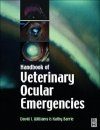![Handbook of Veterinary Ocular Emergencies Handbook of Veterinary Ocular Emergencies]()
Click to have a closer look
About this book
Contents
Customer reviews
Related titles
About this book
Ocular emergencies can present major problems for vets. Signs can be dramatic, manifesting as apparent instant blindness, severe trauma from fights or road accidents, or the acute discoloration of the white of the eye to red or blue. The vet needs to identify quickly what the problem is so that the immediate palliative measures are appropriate and do not make matters worse.
A major feature of Handbook of Veterinary Ocular Emergencies is its unique problem-oriented approach, not used in the standard ophthalmology texts. This is complemented by a section arranged on a more anatomical basis, with appropriate cross-referencing, so that access to the right section is made as easy (and quick!) as possible. Handbook of Veterinary Ocular Emergencies emphasises differential diagnoses and treatment options, showing clearly where the case needs referral to a specialist for resolution. Extra material on background pathogenesis and treatment rationale is provided in boxes. The material needed for the actual emergency will be made readily accessible, using bullet points and easy-to-follow line diagrams.
David Williams is based in the UK. He has recently completed a PhD and is building on an international reputation in both ophthalmology and exotic medicine. His US co-author, Kathie Barrie, is current President of the American College of Veterinary Ophthalmology and a practising vet; she has ensured that the text is of equal relevance to US practice.
Contents
FOREWORD
INTRODUCTORY CHAPTERS
CHAPTER 1: INTRODUCTION
1.1 How to use this book
1.2 Performing an ocular examination in an emergency situation
1.3 Recording observations made in an ocular emergency
1.4 Equipment and aids required to deal with the ocular emergency
1.5 Some preliminary notes on treatment of ocular infections
1.6 Analgesia in ocular emergencies
1.7 Dealing with ocular emergencies in horses and ruminants
1.7.1 Techniques facilitating large animal ocular examination
1.7.2 Techniques facilitating large animal ocular therapeutics
CHAPTER 2: A problem orientated approach
2.1: The red eye
2.2 The painful eye
2.3 The white eye
2.4 The suddenly blind eye
2.5 Ocular lesions in systemic disease
DIAGNOSIS AND TREATMENT OF OCULAR EMERGENCIES
CHAPTER 3: ADNEXA AND ORBIT
3.1: Lid laceration
3.2 Conjunctivitis
3.3 Conjunctival foreign body
3.4 Acute keratoconjunctivitis sicca
3.5 Orbital cellulitis
3.6 Orbital space occupying lesion
CHAPTER 4: GLOBE
4.1: Blunt trauma to the globe
4.2: Globe prolapse
4.3: Penetrating globe injury
CHAPTER 5: CORNEA
5.1: Corneal ulceration
5.1.1: Is an ulcer present? - the use of ophthalmic stains
5.1.2: Three key questions regarding any corneal ulcer
5.1.2.1 Ulcer depth
5.1.2.2 Ulcer healing
5.1.2.3 The cause of the ulcer
5.2 Dealing with different ulcers
5.2.1 The simple healing superficial ulcer
5.2.2 The recurrent or persistent non-healing superficial ulcer
5.2.3 Ulceration secondary to bullous keratopathy
5.2.4 Partial thickness stromal ulceration
5.2.5 Near-penetrating ulcers, descemetocoeles and penetrating ulcers
5.2.6.1 The melting ulcer: diagnosis
5.2.6.2 The melting ulcer: diagnosis
5.3 Corneoscleral laceration
5.3.1 Defining the extent of a corneal laceration
5.3.2 Defining involvement of other ocular structures
5.3.3 Repairing a simple non-penetrating corneal laceration
5.3.4 Repairing a simple perforating corneal laceration
5.3.5 Repairing a corneal laceration complicated by iris inclusion
5.4 Corneal foreign bodies
5.4.1 Recognising a corneal foreign body
5.4.2 Dealing with a non-perforating corneal foreign body
5.4.3 Dealing with a fully penetrating corneal foreign body
5.5 Antibiotics and mydriatic cycloplegia in corneal emergencies
CHAPTER 6: IRIS
6.1 Iritis
6.1.1 Diagnosis: clinical signs
6.1.2 Diagnosis: diagnostic tests
6.1.3 Treatment: pain relief
6.1.4 Treatment: anti-inflammatory medication
6.1.5 Treatment: reducing miosis and preventing synechia formation
6.2 Change in iris appearance
CHAPTER 7: GLAUCOMA
7.1 Diagnosis: clinical signs
7.2 Diagnosis: diagnostic tests
7.3 Treatment: immediate systemic hypotensive therapy
7.4 Treatment: long-term reduction of IOP
7.5 Treatment: neuroprotection
CHAPTER 8: LENS
8.1 Lens luxation
8.2 Diabetic cataract
8.3 Lens capsule rupture and phacoanaphylactic uveitis
CHAPTER 9: RETINA AND VITREOUS
9.1 Retinal detachment
9.1.1 Examination of the animal with a retinal detachment
9.1.2 Treatment of retinal detachment secondary to hypertension
9.1.3 Treatment of retinal detachment in posterior uveitis
9.1.4 Treatment of idiopathic retinal detachment
9.2 Sudden acquired retinal degeneration (SARD)
CHAPTER 10: OPTIC NERVE
10.1 Optic neuritis
10.2 Central blindness
CHAPTER 11: CONCLUSIONS
APPENDIX:
Section 1: Diagnostic methods used in veterinary ophthalmology
Section 2: Ocular Dictionary
Section 3: Ocular Formulary
Customer Reviews
































